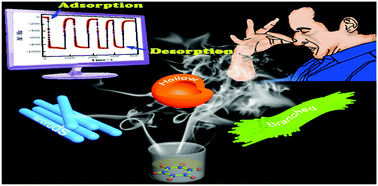Shape-controlled cobalt phosphide nanoparticles as volatile organic solvent sensor†
Abstract
Here we demonstrate shape-controlled cobalt phosphide nanostructures through a one-pot synthetic approach in a single step with precise control over the size, shape and composition. We found that the ratio of the cobalt precursor, phosphorus sources, capping ligands, and annealing time play a key role in determining the morphology of the cobalt phosphide nanostructures. For instance, a zero-to-one-dimensional nanostructure transformation was observed with an increase in annealing time. The aspect ratio of one-dimensional nanorods could flexibly be tuned by a subtle balance of cobalt precursor, phosphorous source and capping ligands. Furthermore, a rod-to-hollow sphere transformation could be observed upon a decrease in the phosphorous source. Of these nanostructures, branched nanowires showed an excellent volatile organic solvent vapor sensing performance selective to benzene compared to the linear chain hydrocarbon hexane. A novel yet simple synthesis strategy with wide varieties of a controlled morphology of cobalt phosphide is expected to open up a new avenue to design other metal phosphide nanostructures, which would offer superior applications in the field of energy harvesting and sensing.



 Please wait while we load your content...
Please wait while we load your content...